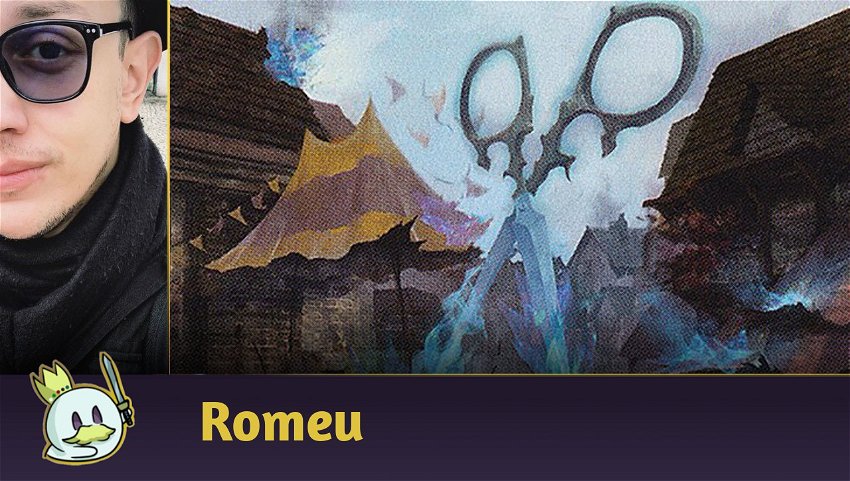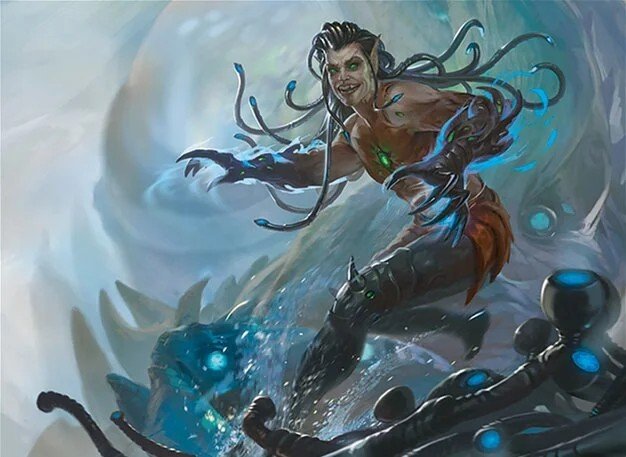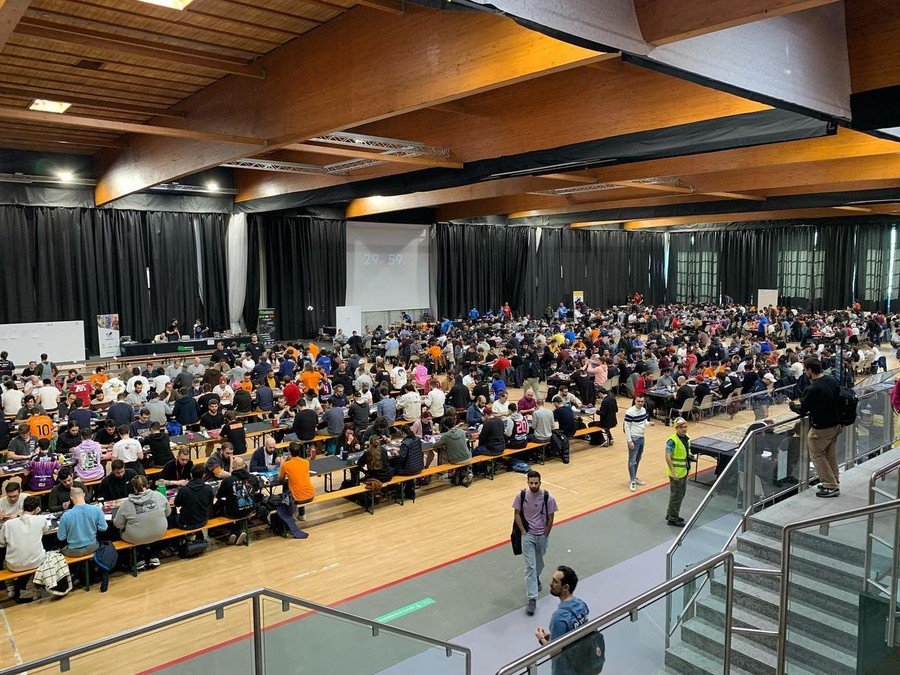Decks with more than one color in Magic tend to have serious difficulties in fitting into the budget category due to the need for dual lands and other cycles for them to work properly. This tends to make your base more expensive, especially in Magic Arena, where many duals are rare and demand the most coveted type of wildcards in our collections.

Shadows Over Innistrad Remastered brought a pleasant surprise by reprinting the Reveal Lands as uncommon, and although the cycle is the worst among the rare lands of Magic Arena (with the rest of them present in Strixhaven), they help in the development of a mana base that can, despite resorting to more than one color, make some optimized plays in the first few turns.
Therefore, in today's article, I present five budget decks in allied colors with the Reveal Lands that you can build now in Magic Arena. In most of them, we resorted to combining the duals with land types from Dominaria United or Kaldheim to add to the color consistency of the decks, but in some, we dared to add some pieces in the mana base that are important to their game plan.
In addition, we will also present optimized versions of these decks, where we will address the necessary changes to improve the commons/uncommons shell of the budget list.
Selesnya Auras
Auras is a deck that became popular on Pioneer due to Benton Madsen's result in Pro Tour Phyrexia. However, the archetype is incomplete in Explorer due to the absence of Gladecover Scout, so we need to improvise however we can.

Paradise Druid is the closest we have to a Hexproof cheap creature in Magic Arena, but only under the condition that it's untapped. Therefore, we've paired her with Sentinel's Eyes to ensure she's always immune to spells and abilities your opponents control.

Then we can add other Auras to the creature to give it evasion or exponentially increase its power, thus making it a threat capable of closing the game in one or two turns.

To complement the threat package, we have Generous Visitor to power up a creature with every Aura you play, and Illuminator Virtuoso is the perfect creature to enchant with our package. However, it has no built-in protection, and Tyvar's Stand is a perfect option to protect it from removals and sweepers while we can power it up.

The mana base consists of eight duals to improve consistency, with the potential to Fortified Village come into play untapped and not delay our early game plays.
Upgraded Version
The improved list is based on the deck piloted by Benton Madsen, with some changes to adapt to the digital platform's card availability, such as the inclusion of Paradise Druid, as well as Illuminator Virtuoso as an efficient clock.

Another excellent addition with rare cards is Light-Paws, Emperor's Voice, as it allows the elaboration of a small toolbox where we have Warbriar Blessing as removal, Rune of Sustenance for the Aggro matchups and Kaya's Ghostform to grant some resilience, while we can also fetch the main Auras of the deck with it, such as Ethereal Armor.

Sram, Senior Edificer offers card advantage while casting our Auras, and since he doesn't need to be the target, we can chain multiple of them onto one or more creatures and still keep a full hand. And Skrelv, Defector Mite is the perfect protection for Auras, and also allows the enchanted creature to run over blockers on several occasions.

Our mana improves a lot with the right dual lands, and Mana Confluence allows access to Kaya's Ghostform or other Auras that are outside the list colors as one-ofs if necessary.
Azorius Ensoul
Azorius Ensoul was one of the first decks to appear on Pioneer since the format was announced, originally in Izzet combinations, but as new sets came out, adding white instead of red became the more plausible option thanks to the support it provided.

The focus on this deck is casting cheap and ineffective creatures and then turning them into bigger threats with Ensoul Artifact and/or All That Glitters and its newer version, Michiko's Reign of Truth. Thus, the opponent will have no option but to try to destroy your creatures to avoid losing the game in a few turns.

Among the additions that became popular on the list, we have Patchwork Automaton and Ingenious Smith as threats that grow as you proceed with the deck's gameplan, in addition to having their own qualities, such as protecting themselves with Ward or offering a card selection when they come into play.

Since Best of One is a mostly creature-oriented format, we need good interactions to remove blockers, and both Portable Hole and Glass Casket helps at dealing with cheap threats while also being artifacts, which allows them to be found by Ingenious Smith or trigger Patchwork Automaton.

As this is a mostly Mono White deck with a splash for Ensoul Artifact, we don't have to worry as much about maxing out our colors, and Port Town does an excellent job on the first turns.
However, to compensate for this lack of more duals and speed up some plays, we have Springleaf Drum, in addition to having Darksteel Citadel among our lands to enchant it with Ensoul Artifact and have a 5/5 creature with Indestructible.
Upgraded Version
Upgrading Azorius Ensoul would mean investing more in consistency, with The Blackstaff of Waterdeep as a recurring Ensoul effect and Stonecoil Serpent as the perfect target for a variety of cards and abilities.

Another addition that I consider pertinent is Skrelv, Defector Mite, which despite not interacting directly with the deck's proposal, guarantees recurring protection to its creatures while also helping them to pass through combat.

There's also a small bundle of equipment that aids strategy, with Shadowspear granting Trample and Lifelink while Eater of Virtue punishes the opponent for killing threats equipped with it by transferring its abilities to the next equipped creature.

Seachrome Coast and Hallowed Fountain ensure good consistency in color diversity alongside Adarkar Wastes, which can be utilized to generate colorless mana, and since most of our list is based on artifacts, we can turn to Mutavault as a complementary threat.
Dimir Terror
Dimir Terror is in essence a Tempo strategy based on one of Pauper's most famous decks today. Your plan is to delay your opponent's game long enough to play your game-ending threats in a few turns while protecting them with cheap spells.

Despite the absence of Gurmag Angler in Explorer, we have Pteramander as a cheap creature, with evasion, that helps a lot to complement the plan proposed by Tolarian Terror without being counterintuitive with it, since both mind having spells in your graveyard without feeding on them.

To accelerate the process, we rely on self-mill and card selection effects such as Consider and Curate to increase the number of spells in our graveyard. We also have Founding the Third Path as a powerful 2-for-1 accelerator and effect, as it lets you cast a spell from your hand for free and then resort to another one in your graveyard, and since it has Read Ahead, we can choose which of the modules is most beneficial for each moment of the game.

The removal package is very flexible, and I tried to diversify it to deal with different situations, but any player can choose the options that seem most efficient in the Metagame.

Resolving non-creature spells is much more concerning because we have few ways to interact with them, so we focus on Spell Pierce and Negate as our Instant-Speed interactions.

In addition, we also have Thought Erasure to remove important threats or answers from our opponent's hand while we put another card in our graveyard, in addition to You See a Guard Approach as an Instant-Speed protection, since we only run eight creatures,, and we can't use Slip Out the Back, as the card is counter-interactive with Pteramander.

We maximized the combination of Common Duals with Choked Estuary to have the appropriate access to colors, but under the consequence that we may be unable to cast Thought Erasure or Founding the Third Path at the proper timing.
Upgraded Version
Aside from an excellent mana base buff, the essence of Dimir Terror remains the same in the upgraded version, with just a few minor changes:

Thoughtseize is the best interaction available in Explorer today, and its addition is almost mandatory in a deck that wants to protect its threats at all costs, it's also one of the main answers against Greasefang, Okiba Boss or another combo in the Metagame.
Speaking of threats, Ledger Shredder interacts with our proposal and helps us filter the hand and remove unwanted cards and/or speed up the number of spells in our graveyard, in addition to serving as a complementary clock. We also rely on See the Truth instead of Curate due to its interaction with Founding the Third Path, which allows us to build our own Treasure Cruise.

We've added some utility lands to increase our ability to play around attrition matches.
Rakdos Sacrifice
Probably the closest deck to the competitive Metagame on this list, Rakdos Sacrifice is well known in Explorer because of the micro-interactions between its permanents.

The most famous among them is Cauldron Familiar and Witch's Oven alongside Mayhem Devil to deal a high amount of recurring damage and/or kill small creatures, making this archetype one of the most feared by Aggro players.

Sacrifice also has a very efficient value package, with Unlucky Witness and Experimental Synthesizer offering card advantage when sacrificed, while Deadly Dispute is a Pauper staple that interacts perfectly with virtually all of its pieces.

To ensure that we always have a way to sacrifice our permanents, I've added two other well-known cards to Pauper: Reckoner's Bargain is basically copies 5 and 6 of Deadly Dispute and offers a card advantage we lack without Fable of the Mirror-Breaker, and Makeshift Munitions is a recurring effect that also deals with small creatures and/or speeds up our clock.

While creatures aren't a problem, we have other interactive effects like Bloodtithe Harvester which doubles as a threat and removal, Fatal Push which, thanks to the other cards, will usually have the range needed to kill Greasefang, Okiba Boss and Sheoldred, the Apocalypse as well as Claim the Firstborn to trade favorably alongside our sacrifice cards.

With eight duals, we managed to maintain good consistency in accessing the colors of the list, and as much as Evolving Wilds interacts well with Mayhem Devil, I don't think the loss of consistency with Foreboding Ruins justifyies a playset.
Upgraded Version
The enhanced version is what we usually see in Pioneer's competitive Metagame, with changes to each player's reading of the format. In this list, I focused on rounding the amount of interactions the deck has between its pieces, but other versions choose to include Thoughtseize to improve the matchup against combo or Midrange.

In addition to the dual lands, the list now receives excellent mana sink effects that allow you to maintain the attrition in the game even with an empty board, with the manlands and Channel Lands.

Kroxa, Titan of Death's Hunger, in addition to functioning as a standalone wincondition, also has several interactions with Rakdos Sacrifice. For example, if you enter full control mode (by pressing the CTRL key), you can respond to his ability by sacrificing him with another effect, such as Witch's Oven or Deadly Dispute, before he is sacrificed by its own trigger.
Priest of Forgotten Gods offers card advantage, clock, mana, and board control. While we can't abuse its effects as well as a list geared specifically for it, we can turn to Claim the Firstborn to mitigate losses while removing two opposing creatures at once.
Since our list doesn't have cards with more than one colored mana in their costs, we can use Jegantha the Wellspring as an additional wincondition from the Sideboard.

Finally, the key upgrade card is Fable of the Mirror-Breaker because it does everything Rakdos Sacrifice (and a dozen other decks) want it to: It puts a token into play that creates Treasure when attacks, which can be sacrificed to trigger, and untapping with Reflections of Kiki-Jiki is lethal alongside Bloodtithe Harvester or Mayhem Devil.
Temur Energy
The ideal would be to present a Gruul list to close the Reveal Lands category, however, the budget strategies in this combination are very similar to what we approached with Azorius Ensoul and Selesnya Auras and end up being less efficient in this regard. Therefore, we will cover in this category the Temur Energy, an aggressive three-color midrange that has a lot of manafixing.

Despite having three colors and a mana base made only of uncommon and common cards, Temur Energy manages to behave well thanks to the inclusion of Attune With Aether and Servant of the Conduit to have access to blue at the right timing.

Your early-game can start off pretty aggressive with Longtusk Cub and Voltaic Brawler, both creatures that can grow as you invest energy into them.

To keep the board clean, we have 12 removals. Strangle is the best one-mana spell in a non-Instant and Sorceries deck and can kill even more troublesome creatures like Bonecrusher Giant or Graveyard Trespasser.
Lightning Strike can be replaced with Obliterating Bolt if a player prefers, but the flexibility of Instant-Speed to kill Greasefang, Okiba Boss and still serve to speed up our clock made me opt for it over the Gruul Midrange staple. Lastly, Harnessed Lightning interacts with our gameplan and can kill even bigger creatures like Sheoldred, the Apocalypse.

To top it off, we have a card advantage package that also plays into our game plan, with Rogue Refiner and Glimmer of Genius giving you more cards in your hand and ensuring you don't run out of steam and Whirler Virtuoso as our main energy investment to create a 1/1 thopter army.

This list has the most tapped lands among the ones presented in this article, but since we are in the Midrange position and have cheap interaction, we can afford to play a tapped land in the first turns, while we prepare our setup.
Upgraded Version
Temur Energy is the only deck that I would not recommend upgrading with the same proposal, as any improved version of it will be a worse option than other decks in the format.
If you want to invest in Bristling Hydra to improve the Midrange plan, it will be more beneficial to try to get the necessary parts to assemble the Gruul Midrange with Bonecrusher Giant, Lovestruck Beast and Esika's Chariot. And if you want to invest in a combo plan with Aetherworks Marvel, Gruul Transmogrify lists are much more efficient and rely on less dead cards in your hand.
No matter what route you choose, Energy's card pool is too limited for it to succeed compared to other archetypes in the same category. Therefore, recommending an upgraded version of it would motivate you to build a worse deck, with no difference from the others in its category, and still spend rare wildcards for it.
That said, if you really want to upgrade, go for the Temur Aetherworks route, especially now that we have Emrakul, the Promised End and Atraxa, Grand Unifier.

The plan for this list is straightforward: accumulate enough energy to activate the artifact, look at the top six cards and hope for a bomb among them. Emrakul, the Promised End can ruin games on its own by controlling the opponent's turn, Atraxa, Grand Unifier might not win the match on its own, but it guarantees another round of Aetherworks Marvel with its ETB effect, and Ugin, the Spirit Dragon is an efficient sweeper and wincondition in a single card.

Other necessary tweaks are the addition of Woodweaver's Puzzleknot both to survive the opponent's initial beatdown and because it guarantees an Aetherworks activation on its own, as well as Valakut Awakening and Fire Prophecy to place your bombs back to the bottom of the deck to be shuffled with Attune with Aether.
Overall, Temur Aetherworks isn't a competitive strategy (and the fact that its centerpiece is locked by Karn, the Great Creator doesn't help), but it's fun when it works and a suitable option for those who like pressing the "free-win" button or want to take full advantage of Emrakul's arrival at Magic Arena.
Conclusion
That's all for today.
Explorer is a relatively well-defined format, but with some room for innovation and new ideas. The decks featured here are intended to give players a low-cost baseline to get to know the format and see if it appeals to them, with strategies that can be effective in the early stages of ranked play. Then everyone can decide the best way to invest in their favorite archetypes.
Thanks for reading!













— 评论 0
, 反应 1
成为第一个发表评论的人